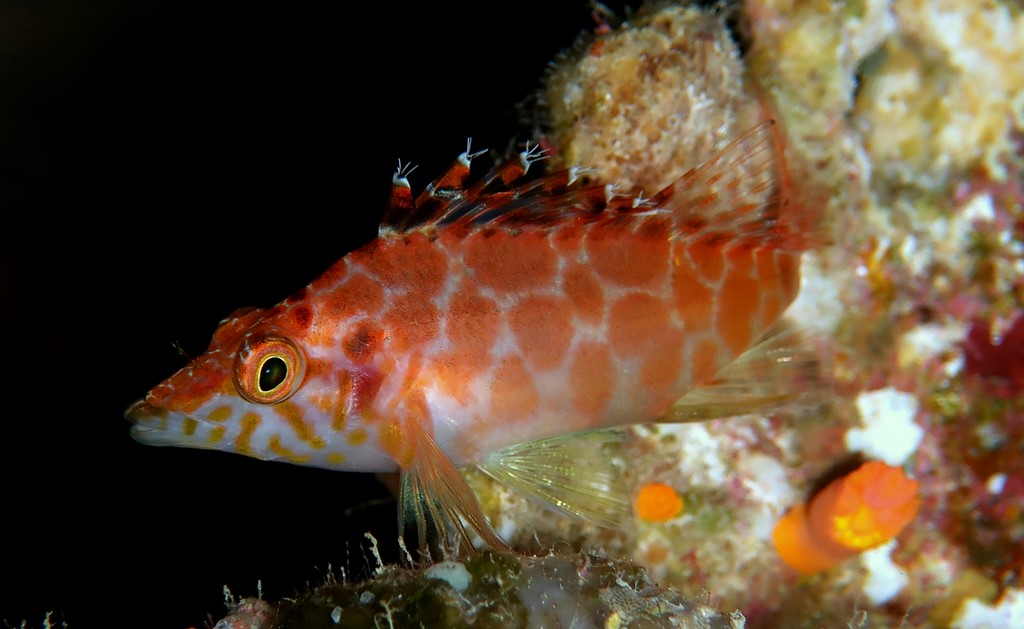CIRRHITICHTHYS GUICHENOTI - (SAUVAGE, 1880)
Picture courtesy of: Alain Daoulas
Actinopterygii (Gigaclass) > Actinopteri (Class) > Teleostei (Subclass) > Centrarchiformes (Order) > Cirrhitioidei (Suborder) > Cirrhitidae (Family) > Cirrhitichthys (Genus)
Épervier des Mascareignes, Cave Hawkfish,
Synonymes
Cirrhites grandimaculatus (Liénard, 1891)
Cirrhites guichenoti (Sauvage, 1880)
Cirrhitichtys guichenoti (Sauvage, 1880)
-------------------------
Distribution
Dorsal spines (total): 10; Dorsal soft rays (total): 13, the first soft ray prolonged; Anal spines: 3; Anal soft rays: 7; Pectoral fin rays: 14; Lateral line scales: 53; 4 rows of large scales above lateral line in middle of body; Gill rakers: 5 + 1 + 11; Depth of body about: 3.1 in Standard Length; Snout: 2.95 in Head Length; Longest dorsal spine about:1.8 in depth; Bony interorbital space about: 2 in eye; Median anterior part of interorbital space and region between nostrils scaled; Profile of head, excluding eye, with a marked indentation above eye; Preorbital with a few small scales posteriorly, the free hind margin without spines; Maxillary ends
before eye; Caudal fin truncate. Max. length: 17.0 cm TL. Depth range: 35 - 70 m.
Color
White base coloration overlaid with a patchwork of heterogenous red blotches.
Etymology
Cirrhitichthys: from Latin, cirrus = curl fringe + from Greek, ichthys = fish. Referring to the cirri found on the dorsal fin and behind the nostrils. The cirri or cirrhes are cilia or filaments found in some fish.
Actinopterygii (Gigaclass) > Actinopteri (Class) > Teleostei (Subclass) > Centrarchiformes (Order) > Cirrhitioidei (Suborder) > Cirrhitidae (Family) > Cirrhitichthys (Genus)
Épervier des Mascareignes, Cave Hawkfish,
Synonymes
Cirrhites grandimaculatus (Liénard, 1891)
Cirrhites guichenoti (Sauvage, 1880)
Cirrhitichtys guichenoti (Sauvage, 1880)
-------------------------
Distribution
Dorsal spines (total): 10; Dorsal soft rays (total): 13, the first soft ray prolonged; Anal spines: 3; Anal soft rays: 7; Pectoral fin rays: 14; Lateral line scales: 53; 4 rows of large scales above lateral line in middle of body; Gill rakers: 5 + 1 + 11; Depth of body about: 3.1 in Standard Length; Snout: 2.95 in Head Length; Longest dorsal spine about:1.8 in depth; Bony interorbital space about: 2 in eye; Median anterior part of interorbital space and region between nostrils scaled; Profile of head, excluding eye, with a marked indentation above eye; Preorbital with a few small scales posteriorly, the free hind margin without spines; Maxillary ends
before eye; Caudal fin truncate. Max. length: 17.0 cm TL. Depth range: 35 - 70 m.
Color
White base coloration overlaid with a patchwork of heterogenous red blotches.
Etymology
Cirrhitichthys: from Latin, cirrus = curl fringe + from Greek, ichthys = fish. Referring to the cirri found on the dorsal fin and behind the nostrils. The cirri or cirrhes are cilia or filaments found in some fish.
guichenoti: in honor of Antoine Alphonse Guichenot (1809-1876), Sauvage’s colleague at "Musée du Jardin des Plantes" from Paris.
Original description: Cirrhites oxycephalus Bleeker, 1855 - Type locality: Réunion, western Mascarenes, southwestern Indian Ocean.
Distribution
Indo-West Pacific: KwaZulu-Natal (South Africa), Mozambique, Comoros, Madagascar and western Mascarenes (La Réunion, Mauritius), Indonesia, south to New Caledonia.
Biology
A species inhabiting caves.
Similar species
Cirrhitichthys aprinus (Cuvier, 1829) - Reported from New Caledonia - Link to the species (here).
Cirrhitichthys oxycephalus (Bleeker, 1855) - Reported from New Caledonia - Link to the species (here).
Last update: 18, March 2023
Original description: Cirrhites oxycephalus Bleeker, 1855 - Type locality: Réunion, western Mascarenes, southwestern Indian Ocean.
Distribution
Indo-West Pacific: KwaZulu-Natal (South Africa), Mozambique, Comoros, Madagascar and western Mascarenes (La Réunion, Mauritius), Indonesia, south to New Caledonia.
Biology
A species inhabiting caves.
Similar species
Cirrhitichthys aprinus (Cuvier, 1829) - Reported from New Caledonia - Link to the species (here).
Cirrhitichthys oxycephalus (Bleeker, 1855) - Reported from New Caledonia - Link to the species (here).
Last update: 18, March 2023
